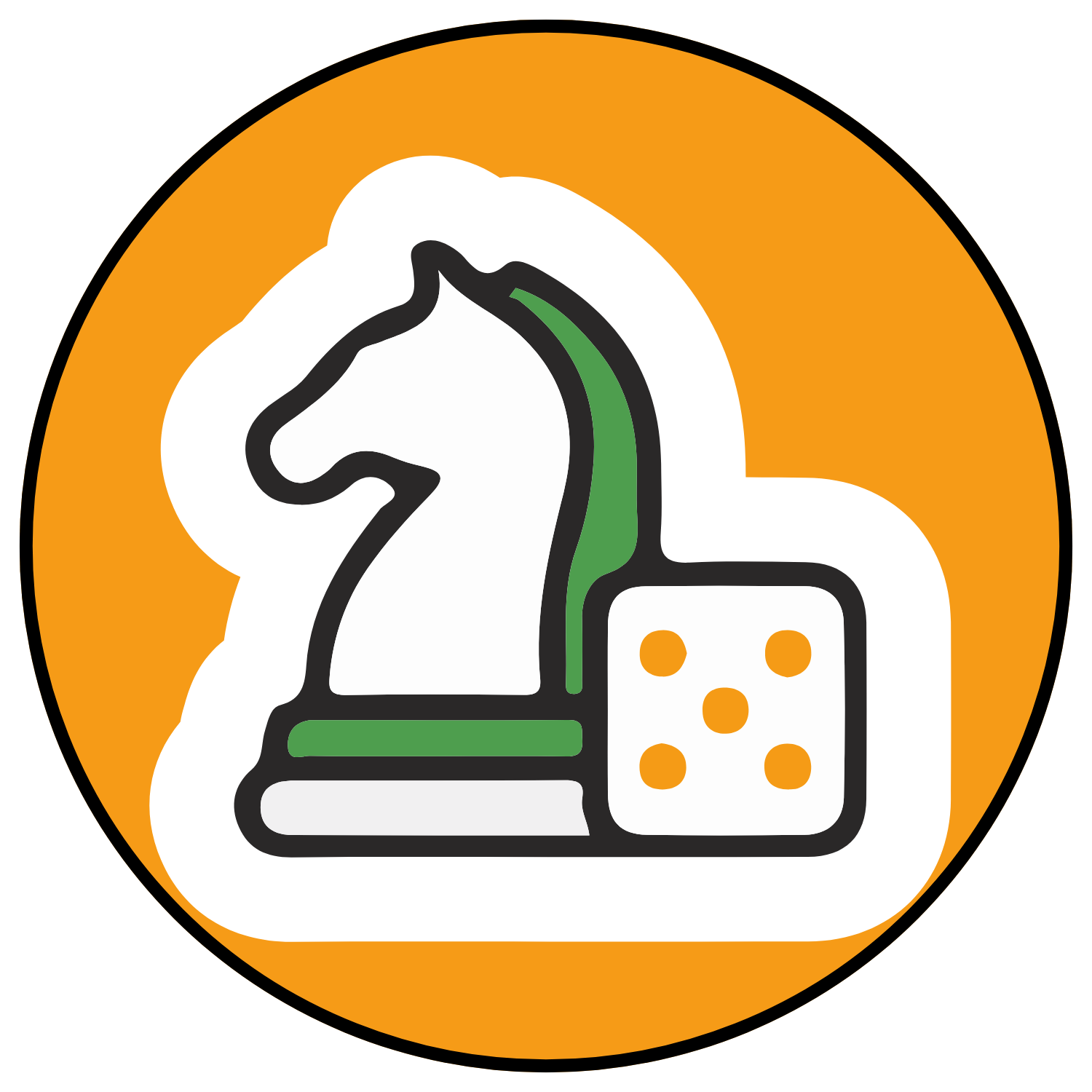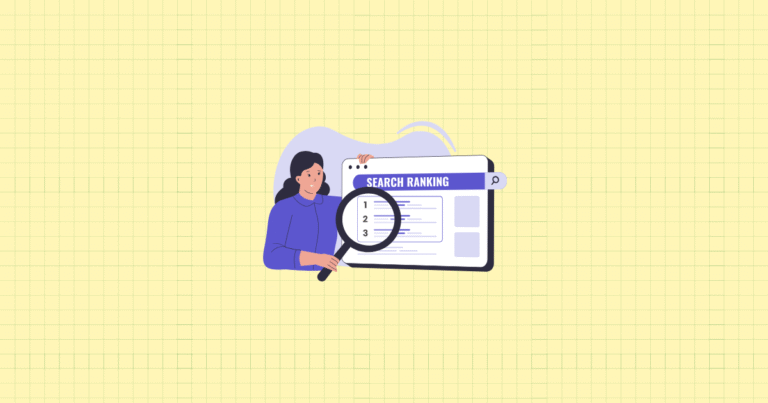That brilliant blog post you spent hours crafting last month? It’s collecting digital dust. The stunning product photos your photographer delivered? They’re buried in your media library. The customer testimonials you’ve gathered? They’re hidden on a single page of your site. Sound familiar?
If you’re like most Shopify store owners, you’re sitting on a goldmine of content that’s vastly underutilized. Here’s the game-changer: you don’t need to create new content constantly. You need to make your existing content work harder for you.
Understanding Content Repurposing in the E-commerce Context
Content repurposing is the art of transforming your existing content into new formats for different platforms. It’s not just copying and pasting—it’s strategically adapting your message to fit various channels while maintaining its core value. Think of it as giving your content multiple lives instead of a single performance.
For Shopify store owners specifically, repurposing is your secret weapon against the constant demand for fresh content. Why? Because e-commerce is a multi-channel game, and your customers interact with your brand across numerous touchpoints before making a purchase decision.
Every piece of content you create has the potential to fuel multiple channels—your blog post can become an email series, social media carousel, product page enhancement, and video script. One asset, multiple returns.
The Business Case for Content Repurposing
Let’s talk numbers. Creating fresh content from scratch typically costs 60-70% more than repurposing existing content. For a small Shopify store with limited resources, that difference is substantial.
Beyond the obvious time and cost savings, repurposed content delivers compounding benefits:
- Consistent messaging: When customers encounter your key messages across different platforms, brand recognition and trust increase dramatically.
- Extended reach: Different audience segments prefer different content formats and platforms. Repurposing helps you meet them where they are.
- Reinforced learning: Marketing research shows that consumers need multiple exposures to information before it sticks—repurposing creates these valuable repeat impressions.
- SEO advantages: Repurposed content creates more entry points to your store through various channels and keywords.
A Shopify apparel store I worked with saw a 43% increase in traffic after implementing a systematic content repurposing strategy—without creating any new cornerstone content. They simply extracted more value from what they already had.
The ROI becomes even clearer when you measure specific metrics:
- Reduced content production costs (typically 30-50% savings)
- Increased traffic from diverse channels (average improvement of 35%)
- Higher engagement rates across platforms (2-3x typical engagement)
- Improved conversion rates from multi-channel exposure (15-25% lift in many cases)
Now that you understand the value, let’s build the foundation for an effective repurposing strategy.
Building a Strategic Foundation for Content Repurposing
Randomly resharing content isn’t a strategy—it’s a shot in the dark. Effective repurposing starts with understanding what content you have, what’s performing well, and how it maps to your customer’s journey.
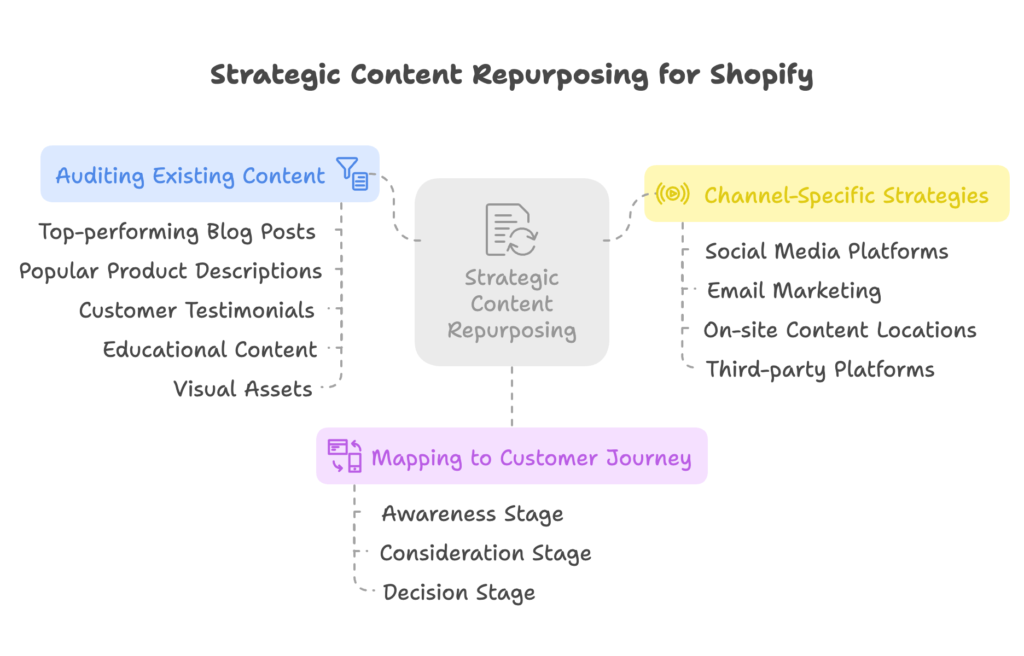
Auditing Your Existing Shopify Content Assets
Before creating anything new, take inventory of what you already have. You’ll likely discover forgotten content gems that can be polished and repurposed for immediate wins.
Start by identifying your high-value content candidates:
- Top-performing blog posts: Check your Google Analytics for posts with the highest traffic, longest time on page, or most conversions.
- Popular product descriptions: Products with high view-to-cart ratios often have compelling descriptions worth repurposing.
- Customer testimonials and reviews: Social proof is versatile content that can strengthen every stage of your funnel.
- Educational content: How-to guides, tutorials, and FAQs typically have long shelf lives and high repurposing potential.
- Visual assets: Product photos, lifestyle images, and graphics can be repurposed across numerous channels.
For each content piece, evaluate performance metrics that matter:
- Traffic and engagement statistics
- Conversion impact
- Social sharing and backlink generation
- Customer feedback (both quantitative and qualitative)
One Shopify home goods store discovered that their “Care Guide” PDFs—barely promoted and hidden on product pages—contained their most valuable content. When repurposed into social posts, emails, and enhanced product tabs, these guides drove a 28% increase in average order value. The content was already there; it just needed strategic distribution.
Mapping Content to Customer Journey Stages
Not all content serves the same purpose. To repurpose strategically, map your content to different stages of the customer journey:
Awareness Stage Content
At this stage, shoppers are just discovering problems or needs. They’re not ready to buy yet. Ideal content includes:
- Educational blog posts that address common pain points
- Industry trend analyses that position you as an authority
- Problem-identification quizzes or assessments
- Beginner’s guides and introductory content
Consideration Stage Content
Now shoppers are actively evaluating solutions and comparing options. Effective content includes:
- Product comparisons and detailed buying guides
- Feature explanations that connect benefits to customer needs
- Case studies showing how others solved similar problems
- Expert interviews and deeper educational content
Decision Stage Content
At this point, shoppers are ready to buy but may need a final push. Valuable content includes:
- Customer testimonials and detailed reviews
- Product specifications and compatibility information
- Pricing comparisons and package details
- Risk-reducers like guarantee information and return policies
By mapping content to these stages, you’ll identify gaps and opportunities. Perhaps you have plenty of decision-stage testimonials that could be reformatted into consideration-stage social proof carousels. Or maybe your awareness-stage blog posts contain compelling statistics that could enhance your product pages.
Developing Channel-Specific Content Strategies
Different channels have different content requirements, audience expectations, and formatting needs. Before repurposing, identify your key channels and understand their unique demands.
Start by identifying the most relevant channels for your Shopify store:
- Social media platforms: Which ones align with your target audience? A B2B Shopify store might prioritize LinkedIn and Twitter, while a fashion retailer might focus on Instagram and TikTok.
- Email marketing: Different email types (promotional, educational, transactional) may require different content approaches.
- On-site content locations: Product pages, collection pages, blog, and landing pages all serve different purposes.
- Third-party platforms: This might include marketplaces, affiliate sites, or partner blogs where your content can appear.
For each channel, understand the specific requirements:
- Format specifications: Optimal image sizes, video lengths, character counts, and formatting limitations
- Audience expectations: Content types that typically perform well and user behavior patterns
- Platform algorithms: Factors that influence content visibility and engagement
A home decor Shopify store found that their lengthy how-to guides performed poorly on Instagram but excelled when broken into tip-focused carousel posts with strong visuals. The same content thrived in both channels—but only when adapted to each platform’s unique environment.
With your foundation in place, let’s explore specific techniques for transforming different content types.
Content Repurposing Techniques for Shopify Stores
Now comes the creative part—transforming your content into different formats for maximum impact across channels.
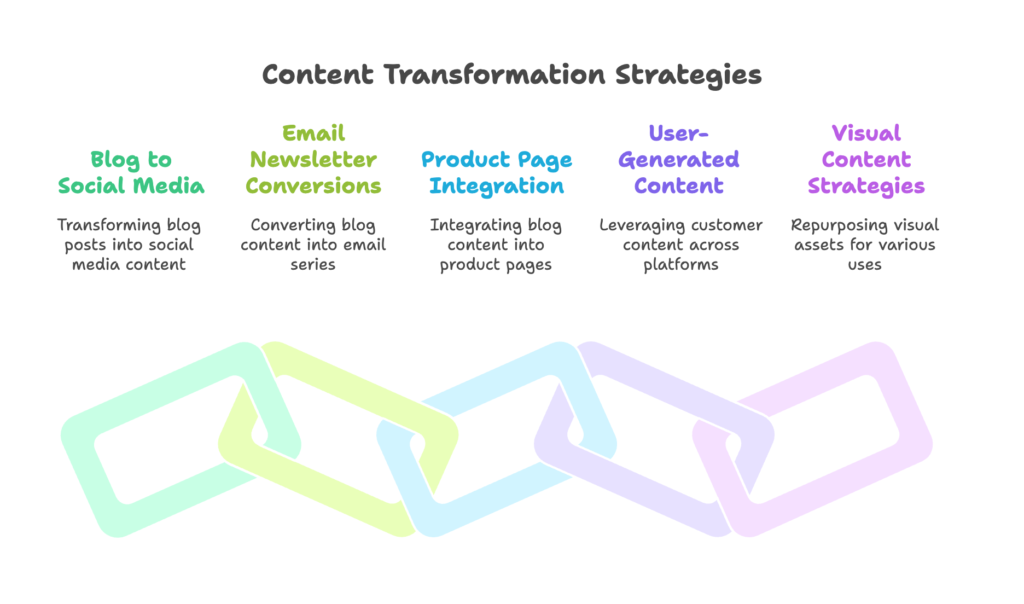
Let’s explore specific techniques for three content categories.
Transforming Blog Content for Multiple Channels
Your blog posts are content powerhouses waiting to be unleashed across channels. Here’s how to transform them effectively:
Blog to Social Media Transformations
Long-form blog content can fuel weeks of social media posts when approached strategically:
- Create image carousels from key points: Extract 5-7 main takeaways from your blog post, pair each with a relevant image, and create a swipeable carousel for Instagram or LinkedIn.
- Develop quote graphics: Pull impactful statements or statistics from your post, overlay them on branded templates, and share as standalone graphics.
- Craft short-form video summaries: Condense your blog’s main points into a 60-second script, add visuals, and create TikTok or Instagram Reels content that drives traffic back to the full post.
- Turn how-to content into step-by-step stories: Break processes from your blog into individual story frames for Instagram or Facebook stories.
A Shopify skincare brand extracted 18 different social media posts from a single “Summer Skin Protection Guide” blog post. Each post targeted different concerns addressed in the article, dramatically extending the content’s reach and lifespan.
Blog to Email Newsletter Conversions
Your blog content can fuel email campaigns that nurture relationships with subscribers:
- Segment long-form content into email series: Break comprehensive guides into a 3-5 part email sequence, building anticipation for each installment.
- Create teaser content: Share compelling excerpts with links back to the full article, tracking which topics generate the most clicks.
- Develop exclusive expanded content: Add subscriber-only sections that go beyond the public blog post, creating incentives for email sign-ups.
Blog to Product Page Integration
Blog content can significantly enhance your product pages and boost conversion rates:
- Extract educational sections for product descriptions: Technical explanations from blog posts can add depth to product features.
- Create FAQ sections: Questions addressed in blog comments can form an FAQ section on related product pages.
- Develop feature highlight sections: Detailed explanations from blogs can be condensed into benefit-focused bullet points.
One Shopify electronics store increased their conversion rate by 24% by adding condensed buying guide content from their blog directly to product pages, helping customers make more confident purchasing decisions.
Leveraging User-Generated Content Across Platforms
User-generated content (UGC) is uniquely powerful because it combines authenticity with social proof. Here’s how to maximize its impact:
Repurposing Customer Reviews and Testimonials
- Create social proof sections on product pages: Group thematic reviews that address specific benefits or common concerns.
- Develop testimonial graphics for social media: Overlay powerful customer quotes on product images or branded backgrounds.
- Incorporate reviews into email marketing: Feature relevant testimonials in abandoned cart emails to overcome objections.
Pro tip: When requesting permission to repurpose customer reviews, ask for a photo to accompany their words. Visual testimonials typically perform 35% better than text-only versions.
Utilizing Customer-Created Visual Content
- Feature customer photos on product pages: Real-world usage photos often convey benefits better than professional shots alone.
- Create social media galleries: Curate themed collections of customer content (e.g., “Weekend Looks” or “Customer Styling Tips”).
- Develop influencer collaboration showcases: Combine micro-influencer content into lookbooks or inspiration galleries.
A Shopify fashion boutique created a “Style Gallery” from customer Instagram posts, which became their second-highest converting page after implementing product tags on each image.
Transforming Customer Questions into Content Assets
- Create FAQ sections: Compile common customer service inquiries into searchable resource pages.
- Develop blog posts from detailed questions: Expand on complex customer inquiries that require in-depth responses.
- Create social media content addressing frequent concerns: Use question-and-answer formats to proactively address common issues.
Repurposing Visual and Product Content
Visual assets often represent significant investment—make them work harder across channels:
Product Photography Repurposing Strategies
- Create lifestyle imagery collections: Group product photos into themed collections for different platforms (workspace setups, outdoor uses, etc.).
- Develop seasonal campaigns: Recontextualize product images for different seasons or holidays with simple graphic overlays.
- Extract detail shots for feature highlights: Zoom in on product details for educational content about craftsmanship or materials.
Product Video Transformation Techniques
- Create short clips for social media: Extract 15-30 second segments from longer demonstrations for platform-specific requirements.
- Extract key frames for static imagery: Capture still frames from videos to create product detail images.
- Develop GIFs and animations: Convert video segments showing product functions or features into looping GIFs for emails and product pages.
One Shopify kitchenware brand created 12 different GIFs from a single product demonstration video, each highlighting a different feature. These GIFs were used across product pages, emails, and social media, resulting in a 17% increase in add-to-cart rates.
Infographic and Data Visualization Repurposing
- Break complex infographics into simpler graphics: Segment comprehensive infographics into focused, platform-optimized pieces.
- Extract key statistics: Pull compelling data points for social posts, email headers, or ad copy.
- Transform visualizations into interactive elements: Convert static charts into interactive product selectors or quiz content.
Now that we’ve covered transformation techniques, let’s explore how to optimize for specific platforms.
Platform-Specific Repurposing Strategies for Shopify Merchants
Each platform has its own language, culture, and technical requirements.
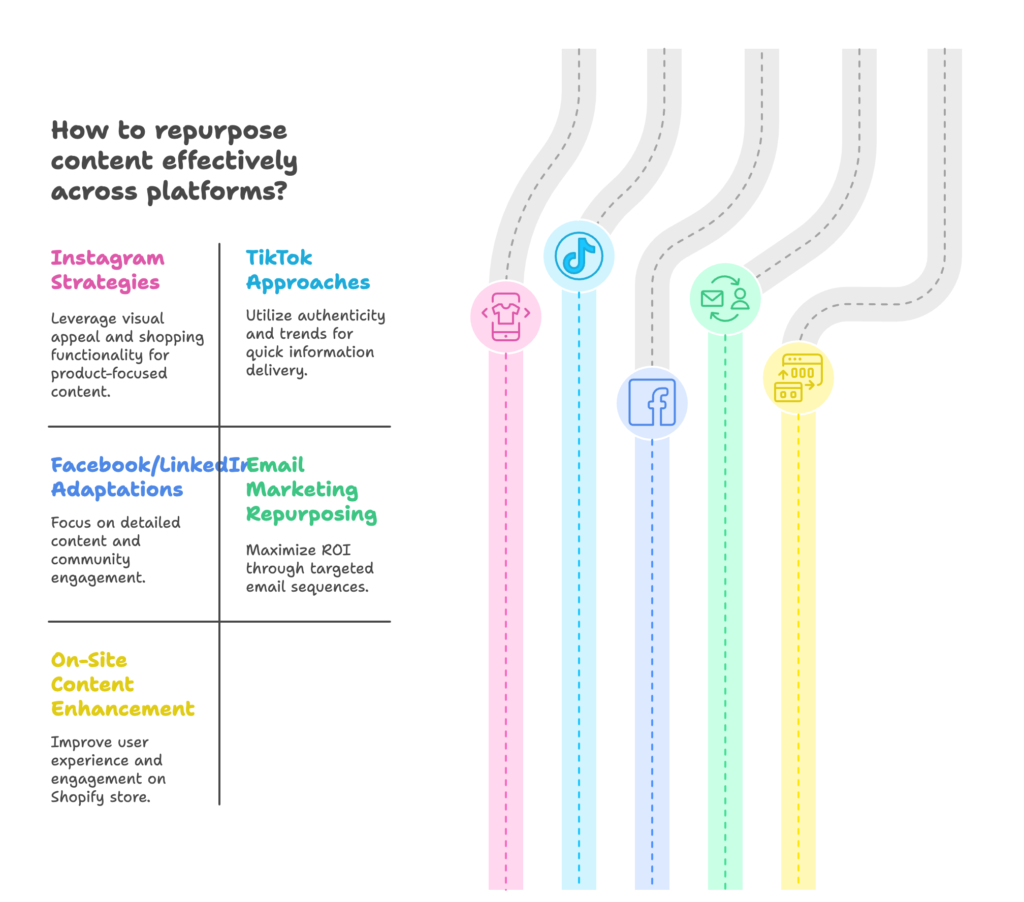
Let’s explore how to adapt your content for maximum impact across key channels.
Social Media Repurposing Tactics
Instagram Strategy
Instagram blends visual appeal with shopping functionality, making it ideal for product-focused content:
- Creating shoppable posts: Transform product catalog images into tagged Instagram posts that link directly to product pages.
- Developing Stories and Reels: Convert longer video content into 15-second story segments or 30-second Reels with music and text overlays.
- Repurposing blog content into carousel posts: Turn list-based articles into swipeable carousels with a single tip per slide.
Product tip: Use Instagram’s “Guides” feature to group related posts into thematic collections, giving older content new visibility and context.
TikTok Approach
TikTok thrives on authenticity, trends, and quick information delivery:
- Creating trend-based content: Adapt product demonstrations to fit current TikTok trends or audio memes.
- Transforming testimonials: Convert written reviews into script formats for authentic “storytime” or reaction videos.
- Developing educational snippets: Break down complex product features into 30-second “Did you know?” videos.
A Shopify beauty brand saw a 340% increase in site traffic after repurposing their product education content into “Beauty Hack” TikTok videos that aligned with platform trends.
Facebook and LinkedIn Content Adaptation
These platforms favor more detailed content and community engagement:
- Repurposing blog content for longer posts: Extract key sections from articles for standalone text posts with added context.
- Creating targeted ad content: Adapt product descriptions into benefit-focused ad copy for specific audience segments.
- Developing group-specific content: Customize general educational content for niche communities or interest groups.
Email Marketing Content Repurposing
Email remains one of the highest-ROI channels for Shopify stores when content is properly adapted:
Post-Purchase Sequence Content
- Repurposing product guides: Transform detailed usage instructions into segmented email content delivered at relevant intervals.
- Converting FAQs into troubleshooting resources: Anticipate common questions and provide answers before customers need to ask.
- Creating complementary product recommendations: Repurpose collection page content into personalized next-purchase suggestions.
One Shopify home appliance store repurposed their product manual content into a 5-email sequence with setup tips, maintenance guidance, and usage ideas. This reduced support tickets by 23% while increasing cross-sell conversion by 14%.
Abandoned Cart Recovery Content
- Repurposing product benefits: Extract key selling points from product pages for reminder emails that reinforce value.
- Creating urgency-focused content: Adapt limited-time offer language from promotional pages for cart abandonment sequences.
- Developing social proof elements: Incorporate relevant reviews that address common purchase hesitations.
Loyalty and Retention Email Content
- Transforming new launches: Convert general release announcements into exclusive preview content for existing customers.
- Repurposing educational content: Adapt how-to content into value-add resources that enhance product usage.
- Creating personalized recommendations: Use browsing data to repurpose relevant product content into tailored suggestions.
On-Site Content Repurposing for Shopify Stores
Your Shopify store itself offers multiple locations for strategic content repurposing:
Product Page Enhancement Strategies
- Incorporating blog content: Add condensed educational sections from relevant articles to build product understanding.
- Adding user-generated content sections: Create galleries or testimonial blocks featuring customer content.
- Creating FAQ sections: Compile and categorize customer questions from email, support tickets, and social media.
Homepage and Collection Page Tactics
- Repurposing campaign content: Adapt seasonal campaign messaging and imagery for homepage banners and announcements.
- Creating featured product sections: Transform product success stories into curated collection highlights.
- Developing category descriptions: Adapt relevant blog content into contextual information for collection pages.
Checkout and Post-Purchase Page Optimization
- Repurposing trust signals: Adapt security information and guarantees for strategic placement during checkout.
- Creating cross-sell recommendations: Repurpose “frequently bought together” data into personalized suggestions.
- Developing loyalty program promotions: Transform membership benefits into targeted upsell opportunities.
With platform-specific strategies established, let’s examine how to implement content repurposing efficiently using Shopify’s ecosystem.
Technical Implementation of Content Repurposing on Shopify
The right tools and workflows can transform content repurposing from an occasional tactic to a systematic growth strategy.
Shopify Apps and Tools for Content Repurposing
Content Management Apps
These tools help organize and distribute your content across channels:
- Blog and article management: Apps like Blogfeeder and DropInBlog enable better content organization and cross-posting.
- Social media integration: Social Sharing by Shopify and Socialshopwave allow automatic content distribution.
- User-generated content collection: Yotpo and Stamped.io gather and organize customer reviews and photos.
Visual Content Creation Tools
These solutions streamline the transformation of content into different formats:
- Image editing and graphic design: Canva and Adobe Express offer templates optimized for different platforms.
- Video creation and editing: Clipchamp and InVideo simplify converting static content to video formats.
- Animation and GIF creation: GIPHY and Animoto can transform product photos into engaging animations.
Content Distribution and Scheduling Tools
These applications help manage the flow of repurposed content:
- Social media management: Later and Buffer allow scheduled posting of repurposed content.
- Email marketing automation: Klaviyo and Omnisend enable targeted distribution of repurposed email content.
- Content calendar solutions: CoSchedule and Trello help plan and track repurposing workflows.
One Shopify jewelry store used Yotpo to collect customer photos, Canva to create Instagram-ready graphics from these images, and Later to schedule a month’s worth of social content—all while saving 15 hours per week compared to their previous process.
Implementing Content Repurposing Workflows
Efficient workflows transform content repurposing from an afterthought to a core strategy:
Creating Efficient Content Production Processes
- Content batching: Create related content in themed groups that can be repurposed together (e.g., summer collection product photos alongside seasonal lifestyle content).
- Template development: Build reusable templates for common repurposing needs like social graphics, email segments, and product page sections.
- Style guide implementation: Ensure consistent branding across all repurposed formats with clear guidelines for colors, fonts, and voice.
Establishing Content Repurposing Protocols
- Content tagging systems: Implement tags in your CMS to easily identify high-potential content for repurposing.
- Repurposing checklist development: Create platform-specific checklists to ensure optimal adaptation.
- Quality control workflows: Establish review processes to maintain content integrity across transformations.
A systematic approach pays dividends. One Shopify home goods store implemented a “create once, publish everywhere” workflow that reduced their content production time by 62% while increasing their publishing frequency by 40%.
Measuring and Optimizing Repurposed Content
- Setting up tracking parameters: Use UTM codes to track performance of repurposed content across channels.
- Implementing A/B testing: Test different formats and adaptations to identify winning approaches.
- Developing performance dashboards: Create centralized reporting to measure content ROI across all its versions.
With the technical foundation established, let’s explore advanced strategies to take your content repurposing to the next level.
Advanced Content Repurposing Strategies for Shopify Growth
Once you’ve mastered the basics, these advanced strategies can further multiply your content’s impact.
Seasonal and Campaign-Based Repurposing
Strategic timing can breathe new life into existing content:
Holiday and Special Event Content Adaptation
- Transforming evergreen content: Add seasonal angles to year-round content (e.g., winterizing tips for your product).
- Creating themed collections: Group existing products into seasonal categories with fresh context.
- Developing limited-time offers: Adapt standard promotions with holiday urgency and gifting angles.
A Shopify kitchenware store repurposed their general recipe content into themed collections for each major holiday, resulting in 218% higher engagement during key selling seasons.
New Product Launch Content Maximization
- Repurposing product development stories: Transform behind-the-scenes content into multi-channel narratives.
- Creating anticipation content: Break product features into teaser content for pre-launch campaigns.
- Developing comparison content: Position new products within your existing catalog through comparison charts and guides.
Sale and Promotion Content Strategies
- Adapting standard product content: Overlay promotional messaging on existing product assets.
- Creating urgency-focused messaging: Transform benefit statements into time-sensitive promotion language.
- Developing exclusivity content: Repackage standard offers as VIP or loyalty member specials.
Cross-Brand and Collaborative Content Repurposing
Partnerships multiply your content’s reach and credibility:
Partner and Influencer Content Integration
- Repurposing influencer-created content: Adapt social posts from partners into product page elements and email features.
- Transforming partnership announcements: Break collaboration news into platform-specific formats for maximum reach.
- Creating co-branded content: Develop assets that serve both your audience and your partner’s followers.
One Shopify athletic wear brand repurposed content from their fitness instructor partnerships across their product pages, resulting in a 34% lift in conversion rate for featured items.
Marketplace and Multi-Channel Selling Adaptations
- Optimizing product content for different marketplaces: Adapt descriptions to meet Amazon, eBay, or Etsy-specific requirements and shopper expectations.
- Creating channel-specific imagery: Modify product photography to match the aesthetic of each selling platform.
- Developing platform-optimized pricing content: Adjust how bundles, discounts, and promotions are presented for each channel.
Community and Affiliate Content Leverage
- Repurposing affiliate-created reviews: Adapt partner content for your own channels with permission.
- Transforming community discussions: Convert customer questions and answers into structured FAQ content.
- Creating testimonial collections: Curate theme-based feedback from community forums into focused social proof assets.
Personalization and Dynamic Content Repurposing
Advanced personalization can dramatically increase the effectiveness of repurposed content:
Customer Segment-Specific Content Adaptation
- Repurposing core content for different demographics: Adapt messaging and examples to resonate with specific age groups or interests.
- Creating interest-based variations: Modify product highlights based on customer behavior patterns.
- Developing loyalty tier-specific content: Tailor messaging complexity and offers based on customer relationship stage.
Behavioral and Contextual Content Customization
- Adapting content based on browsing history: Show product content that complements previously viewed items.
- Creating device-specific variations: Optimize content presentation for mobile versus desktop shoppers.
- Developing location-based adaptations: Adjust imagery and references to match seasonal differences across regions.
A Shopify outdoor gear retailer implemented dynamic content repurposing based on visitor location, showing winter products to northern visitors and summer items to southern regions—increasing relevance and conversion by 28%.
Testing and Optimization Frameworks
- Implementing A/B testing for content variations: Test different adaptations against each other to identify winners.
- Creating performance-based selection systems: Automatically display the highest-converting version of repurposed content.
- Developing continuous improvement protocols: Establish regular review cycles to refine repurposing tactics.
With these advanced strategies in place, let’s explore how to measure success and continuously optimize your repurposing efforts.
Measuring Success and Optimizing Your Content Repurposing Strategy
What gets measured gets improved. Establishing the right metrics and systems is crucial for content repurposing success.
Establishing KPIs for Content Repurposing
Track these key metrics to evaluate your repurposing effectiveness:
Traffic and Engagement Metrics
- Channel-specific traffic attribution: Measure how each repurposed format drives site visitors.
- Engagement rate comparisons: Compare how different formats of the same content perform (e.g., video versus infographic).
- Time-on-page and consumption metrics: Track how thoroughly users engage with different content adaptations.
Conversion and Revenue Metrics
- Conversion path analysis: Identify which repurposed content formats appear in successful purchase journeys.
- Revenue attribution: Measure direct and assisted conversions from repurposed content.
- Customer acquisition cost comparisons: Calculate how repurposed content affects your CAC across channels.
Efficiency and Resource Utilization Metrics
- Content production time tracking: Measure hours saved through repurposing versus creating from scratch.
- Resource allocation optimization: Track team time and budget efficiency with repurposing workflows.
- Content lifespan assessment: Measure how repurposing extends the useful life of your content investments.
A Shopify wellness brand tracked their content repurposing metrics and discovered that their Instagram carousel transformations of blog content delivered a 340% higher ROI than creating standalone social posts. This insight allowed them to reallocate resources to their highest-performing formats.
Analytics and Reporting Frameworks
Implement these systems to gain actionable insights:
Setting Up Cross-Channel Tracking
- UTM parameter implementation: Use consistent tracking codes to follow content across platforms.
- Conversion path analysis: Set up multi-touch attribution to understand how repurposed content works together.
- Attribution model development: Create weighted models that accurately value different content touchpoints.
Creating Content Performance Dashboards
- Channel-specific visualization: Build comparative views of how content performs across platforms.
- Format comparison reporting: Track which content adaptations deliver the best results for each goal.
- Time-based performance trending: Monitor how content effectiveness evolves throughout its lifecycle.
Implementing Continuous Improvement Processes
- Regular content audits: Schedule periodic evaluations of your content’s performance and repurposing potential.
- A/B testing frameworks: Create systematic experimentation schedules for different repurposing approaches.
- Feedback collection systems: Gather qualitative input on repurposed content from customers and team members.
Future-Proofing Your Content Repurposing Strategy
Prepare for ongoing evolution in content consumption and distribution:
Adapting to Platform and Algorithm Changes
- Monitoring platform updates: Stay alert to changing requirements and opportunities.
- Developing format-flexible content: Build core content that can easily adapt to new platform needs.
- Creating platform-independent repositories: Maintain content in flexible formats for future repurposing.
Scaling Content Repurposing for Growth
- Implementing automation: Identify repetitive repurposing tasks that can be streamlined with technology.
- Developing team capabilities: Train staff in effective repurposing techniques and platform-specific requirements.
- Creating scalable content systems: Build content architectures that support increasing repurposing demands.
Emerging Technologies and Content Repurposing
- AI and machine learning applications: Explore tools that can suggest or even automate content adaptations.
- Voice and visual search optimization: Prepare content for emerging search modalities.
- Augmented reality integration: Consider how product content can be repurposed for immersive experiences.
The Shopify stores that excel at content repurposing don’t just do more with less—they create integrated content ecosystems where each piece strengthens the others. One beauty brand I worked with increased their content output by 300% while reducing production time by 40% through systematic repurposing. Their secret wasn’t working harder; it was working smarter with the content they already had.
Content repurposing isn’t just a tactical approach to content management; it’s a strategic mindset that values efficiency, consistency, and adaptability. By implementing the strategies outlined in this guide, you’ll extract maximum value from every piece of content you create, driving better results across all your marketing channels.
References
- Shopify Blog. (2025, February 18). How To Promote Your Blog in 9 Simple Steps (2025). https://www.shopify.com/blog/promote-your-blog
- Shopify Enterprise Blog. (2024, July 15). 12 Top Influencer Marketing Trends in 2024. https://www.shopify.com/enterprise/blog/influencer-marketing-trends
- Ecommerce Fast Lane. (2025, March 5). Content Repurposing: The Ecommerce Growth Hack You’re Missing. https://ecommercefastlane.com/content-repurposing-for-ecommerce-with-ai/
- Sweans. (2024, December 24). 10 eCommerce Content Marketing Strategies for Shopify Sales. https://www.sweans.com/10-shopify-ecommerce-content-marketing-strategies/
Ready to supercharge your Shopify store’s sales with perfectly optimized discount campaigns? Growth Suite helps you create personalized, time-limited offers that drive conversions and increase revenue. With AI-powered analytics and easy campaign setup, you can turn browsers into buyers without complex coding or design work. Install Growth Suite with a single click and start seeing results immediately!
Don’t forget to check other articles;
